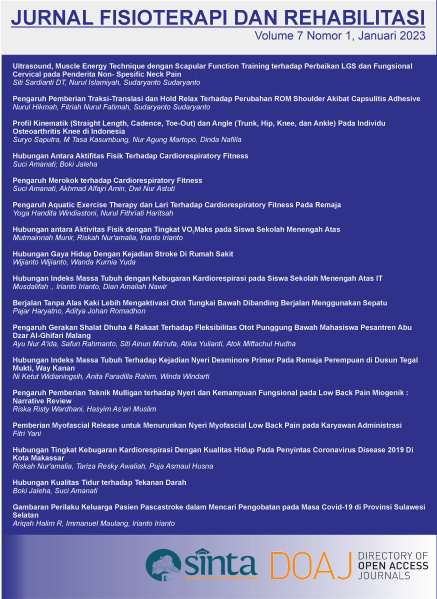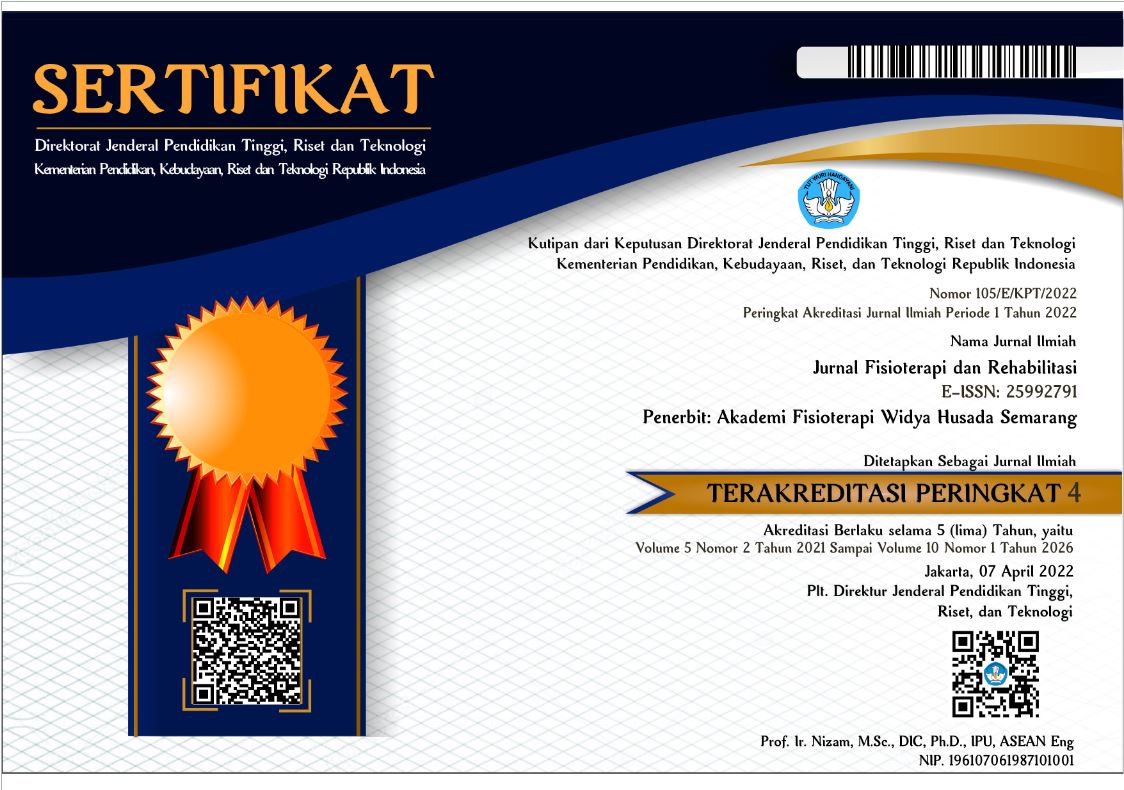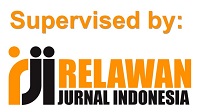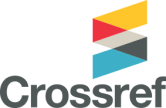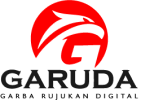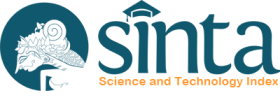Hubungan Indeks Massa Tubuh dengan Kebugaran Kardiorespirasi pada Siswa Sekolah Menengah Atas IT
Correlation between Body Mass Index and Cardiorespiratory Fitness in IT Senior High School Students
Abstract
Peningkatan indeks massa tubuh akan diikuti dengan peningkatan jumlah lemak tubuh akan mengakibatkan terjadinya penebalan pada dinding vertikel jantung sehingga fungsi fisiologis jantung akan menurun. Akibatnya hanya sedikit darah kaya oksigen yang dapat diedarkan keseluruh sel tubuh. Peningkatan jaringan lemak tubuh akan mengganggu fungsi kardiorespirasi dan mempengaruhi tingkat VO₂Maks. Penelitian ini bertujuan untuk mengetahui hubungan antara indeks massa tubuh dengan kebugaran kardiorespirasi pada Siswa SMA IT Pondok Pesantren Putri Darul Istiqamah Maros. Penelitian ini merupakan penelitian kuantitatif yang bersifat asosiatif atau kolerasional dengan pendekatan cross sectional dan metode purposive sampling dengan jumlah sampel sembilan puluh (n=90) yang merupakan siswa SMA IT Pondok Pesantren Putri Darul Istiqamah Maros. Data yang diperoleh berupa tingkat IMT dan VO₂Maks. Data diperoleh dari pengukuran secara langsung. Penelitian ini mendapatkan hasil nilai Sig. (2-tailed) sebesar 0.000 (<0.05) yang berarti variabel IMT memiliki hubungan yang signifikan dengan variabel VO₂Maks. Nilai correlation coefficient bernilai negatif sebesar -0.574 dengan tingkat hubungan yang kuat. Jadi terdapat hubungan negatif antara indeks massa tubuh (IMT) dengan kebugaran kardiorespirasi (VO₂Maks) yang signifikan.
Downloads
References
Alamsyah, D. A. N., Hestiningsih, R. dan Saraswati, L. D. (2017) ‘Faktor-Faktor Yang Berhubungan Dengan Kebugaran Jasmani Pada Remaja Siswa Kelas Xi Smk Negeri 11 Semarang’, Jurnal Kesehatan Masyarakat (e-Journal), 5(3), pp. 77–86.
Alfarisi, R. and Rivai, P. P. (2017) ‘Hubungan Indeks Massa Tubuh Terhadap Ketahanan Kardiorespirasi Diukur Dari VO2Max Pada Mahasiswa Fakultas Kedokteran Universitas Malahayati’, Jurnal ilmu Kedokteran dan Kesehatan, 4(April), pp. 67–73.
Andrastea, K. D. P., Karmaya, I. N. M. dan Wardana, I. N. G. (2018) ‘Hubungan indeks massa tubuh dengan tingkat kebugaran kardiovaskular pada mahasiswi Program Studi Pendidikan Dokter, Fakultas Kedokteran Universitas Udayana usia 18-21 tahun’, Bali Anatomy Journal, 1(2), pp. 30–34. doi: 10.36675/baj.v1i2.16.
Firdausi, D. K. A. dan Simbolon, M. E. M. (2018) ‘Asosiasi Antara Indeks Massa Tubuh Dan Daya Tahan Respirasi Di Kalangan Remaja Kepulauan Bangka Belitung’, Multilateral Jurnal Pendidikan Jasmani dan Olahraga, 17(1). doi: 10.20527/multilateral.v17i1.5006.
Gantarialdha, N. (2021) ‘Hubungan Indeks Massa Tubuh Terhadap Ketahanan Kardiorespirasi Dinyatakan Dalam Vo2Max’, Jurnal Medika Hutama, 02(04), pp. 439–447.
Ghassani, N. (2020) ‘Hubungan Usia dan Indeks Massa Tubuh dengan VO2 Max pada Pemain Basket di Mataram Basketball School dan Bima perkasa Academy’, pp. 1–14.
Hasnah, Irianto dan Leksonowati, S. S. (2019) ‘The Effect Of Freeletic Sport To VO₂ Max Levels On The Freeletic Community Members’, 4(1), pp. 14–18.
Irianto, Immanuel, M. and Mulyadi (2020) ‘The relationship between biking activities and VO2 max level in fixie bike Makassar community members’, Enfermeria Clinica, 30, pp. 304–307. doi: 10.1016/j.enfcli.2020.06.068.
Krismawati, L. D. E., Andayani, N. L. N. dan Wahyuni, N. (2019) ‘Hubungan Antara Aktivitas Fisik Dengan Indeks Massa Tubuh (Imt) Pada Remaja Usia 16-18 Tahun Di Sma Negeri 2 Denpasar’, Majalah Ilmiah Fisioterapi Indonesia, 7(1), pp. 29–32.
Lestari, K. D. P. et al. (2020) ‘Hubungan Indeks Massa Tubuh, Persentase Lemak Total Tubuh Dan Aktivitas Fisik Terhadap Tingkat Volume Oksigen Maksimal Pada Remaja Putri Di Denpasar Selatan’, Majalah Ilmiah Fisioterapi Indonesia, 8(1), p. 49. doi: 10.24843/mifi.2020.v08.i01.p11.
Mohammad, K. dan Dasuki, S. (2018) ‘Sleep Quality Influences Body Mass Index Of High Schooler’, pp. 587–594.
Mustakim and Surury, I. (2020) ‘Kebugaran Dan Faktornya Pada Mahasiswa Fakultas Kedokteran Dan Kesehatan Universitas Muhammadiyah Jakarta’, Jurnal Publikasi Kesehatan Masyarakat Indonesia, 6(3), p. 91. doi: 10.20527/jpkmi.v6i3.8180.
Ninzar, K. (2018) ‘Tingkat Daya Tahan Aerobik (VO2 Max) pada Anggota Tim Futsal Siba Semarang’, Jurnal Mitra Pendidikan, 2(8), pp. 738–749.
Nuraini, A. dan Murbawani, E. A. (2019) ‘Hubungan Antara Ketebalan Lemak Abdominal Dan Kadar Serum High Sensitivity C-Reactive Protein (Hs-Crp) Pada Remaja’, Journal of Nutrition College, 8(2), p. 81. doi: 10.14710/jnc.v8i2.23817.
Nurmitasari, G. (2020) ‘Faktor-faktor Yang Mempengaruhi Nilai VO2Max Pada Remaja Dengan Metode Narrative Review’, Naskah Publikasi, pp. 1–15.
Pranata, D. Y. (2017) ‘Hubungan Indeks Massa Tubuh Dengan Tingkat VO2max Pemain Sepak Bola STKIP BBG’, IV, pp. 64–69.
Pratiwi, A. A. and Nindya, T. S. (2017) ‘Hubungan Konsumsi Camilan dan Durasi Waktu Tidur dengan Obesitas di Permukiman Padat Kelurahan Simolawang, Surabaya’, Amerta Nutrition, 1(3), p. 153. doi: 10.20473/amnt.v1i3.6240.
Rahmawati, A. D. (2015) ‘Kepatuhan Santri Terhadap Aturan di Pondok Pesantren Modern’, Program Magister Psikologi Sekolah Pascasarjana UMS, p. 4.
Sabaruddin, F. (2020) ‘Analysis of Body Mass Index on Vo2Max Men Basketball Team Rooster Gowa Regency’.
Safitri, I. and Dieny, F. F. (2015) ‘Pengaruh Sari Umbi Bit (Beta Vulagaris) Terhadap VO₂Max Atlet Sepak Bola’, 4, pp. 541–546.
Sharma, M., Kamal, R. B. dan Chawla, K. (2016) ‘Correlation of body composition to aerobic capacity’, International Journal of Applied Research Test, 2, pp. 38–42.
Teresa, S., Widodo, S. dan Winarni, T. I. (2018) ‘Hubungan Body Mass Index Dan Persentase Lemak Tubuh Dengan Volume Oksigen Maksimal Pada Dewasa Muda’, Diponegoro Medical Journal (Jurnal Kedokteran Diponegoro), 7(2), pp. 840–853.
Wibowo, C. dan Dese, D. C. (2019) ‘Hubungan Indeks Masa Tubuh Dengan Vo2Max Pada Atlet Bolabasket’, Physical Education, Health and Recreation, 3(2), pp. 19–25.
Yusuf, R. N. dan Ibrahim (2019) ‘Jurnal Kesehatan Saintika Meditory Correlation Of Body Mass Index (BMI) With Cholesterol’, Jurnal Kesehatan Saintika Meditory, 1, pp. 50–56.

This work is licensed under a Creative Commons Attribution 4.0 International License.
The use of the article will be governed by the Creative Commons Attribution license as currently displayed on Creative Commons Attribution 4.0 International License.
Author’s Warranties
The author warrants that the article is original, written by stated author(s), has not been published before, contains no unlawful statements, does not infringe the rights of others, is subject to copyright that is vested exclusively in the author and free of any third party rights, and that any necessary written permissions to quote from other sources have been obtained by the author(s).
User Rights
JFR's spirit is to disseminate articles published are as free as possible. Under the Creative Commons license, JFR permits users to copy, distribute, display, and perform the work. Users will also need to attribute authors and JFR on distributing works in the journal.
Rights of Authors
Authors retain all their rights to the published works, such as (but not limited to) the following rights;
- Copyright and other proprietary rights relating to the article, such as patent rights,
- The right to use the substance of the article in own future works, including lectures and books,
- The right to reproduce the article for own purposes,
- The right to self-archive the article
Co-Authorship
If the article was jointly prepared by other authors, any authors submitting the manuscript warrants that he/she has been authorized by all co-authors to be agreed on this copyright and license notice (agreement) on their behalf, and agrees to inform his/her co-authors of the terms of this policy. JFR will not be held liable for anything that may arise due to the author(s) internal dispute. JFR will only communicate with the corresponding author.
Miscellaneous
JFR will publish the article (or have it published) in the journal if the article’s editorial process is successfully completed. JFR's editors may modify the article to a style of punctuation, spelling, capitalization, referencing and usage that deems appropriate. The author acknowledges that the article may be published so that it will be publicly accessible and such access will be free of charge for the readers as mentioned in point 3.

